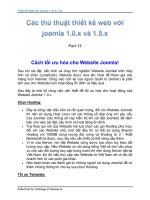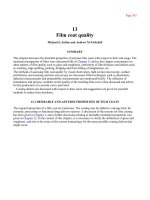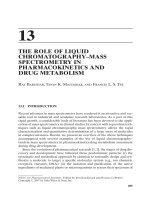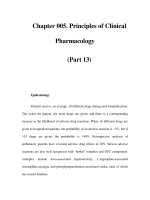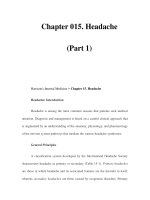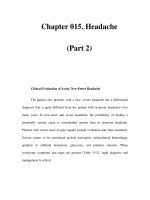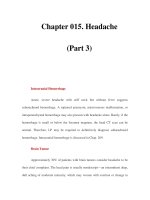Chapter 015. Headache (Part 13) docx
Bạn đang xem bản rút gọn của tài liệu. Xem và tải ngay bản đầy đủ của tài liệu tại đây (13.33 KB, 5 trang )
Chapter 015. Headache
(Part 13)
a
Commonly used preventives are listed with reasonable doses and common
side effects. Not all listed medicines are approved by the FDA; local regulations
and guidelines should be consulted.
b
Not available in the United States.
The probability of success with any one of the antimigraine drugs is 50–
75%. Many patients are managed adequately with low-dose amitriptyline,
propranolol, topiramate, gabapentin, or valproate. If these agents fail or lead to
unacceptable side effects, second-line agents such as methysergide or phenelzine
can be used. Once effective stabilization is achieved, the drug is continued for 5–6
months and then slowly tapered to assess the continued need. Many patients are
able to discontinue medication and experience fewer and milder attacks for long
periods, suggesting that these drugs may alter the natural history of
migraine.[newpage]
Tension-Type Headache
Clinical Features
The term tension-type headache (TTH) is commonly used to describe a
chronic head-pain syndrome characterized by bilateral tight, bandlike discomfort.
The pain typically builds slowly, fluctuates in severity, and may persist more or
less continuously for many days. The headache may be episodic or chronic
(present >15 days per month).
A useful clinical approach is to diagnose TTH in patients whose headaches
are completely without accompanying features such as nausea, vomiting,
photophobia, phonophobia, osmophobia, throbbing, and aggravation with
movement. Such an approach neatly separates migraine, which has one or more of
these features and is the main differential diagnosis, from TTH. However, the
International Headache Society's definition of TTH allows an admixture of nausea,
photophobia, or phonophobia in various combinations, illustrating the difficulties
in distinguishing these two clinical entities. Patients whose headaches fit the TTH
phenotype and who have migraine at other times, along with a family history of
migraine, migrainous illnesses of childhood, or typical migraine triggers to their
migraine attacks, may be biologically different from those who have TTH
headache with none of the features.
Pathophysiology
The pathophysiology of TTH is incompletely understood. It seems likely
that TTH is due to a primary disorder of CNS pain modulation alone, unlike
migraine, which involves a more generalized disturbance of sensory modulation.
Data suggest a genetic contribution to TTH, but this may not be a valid finding:
given the current diagnostic criteria, the studies undoubtedly included many
migraine patients. The name tension-type headache implies that pain is a product
of nervous tension, but there is no clear evidence for tension as an etiology.
Muscle contraction has been considered to be a feature that distinguishes TTH
from migraine, but there appear to be no differences in contraction between the
two headache types.
Tension-Type Headache: Treatment
The pain of TTH can generally be managed with simple analgesics such as
acetaminophen, aspirin, or NSAIDs. Behavioral approaches including relaxation
can also be effective. Clinical studies have demonstrated that triptans in pure TTH
are not helpful, although triptans are effective in TTH when the patient also has
migraine. For chronic TTH, amitriptyline is the only proven treatment (Table 15-
7); other tricyclics, selective serotonin reuptake inhibitors, and the
benzodiazepines have not been shown to be effective. There is no evidence for the
efficacy of acupuncture. Placebo controlled trials of botulinum toxin type A in
chronic TTH have not shown benefit.
Trigeminal Autonomic Cephalalgias, Including Cluster Headache
The trigeminal autonomic cephalalgias (TACs) are a group of primary
headaches that includes cluster headache, paroxysmal hemicrania, and SUNCT
(short-lasting unilateral neuralgiform headache attacks with conjunctival injection
and tearing).
TACs are characterized by relatively short-lasting attacks of head pain
associated with cranial autonomic symptoms, such as lacrimation, conjunctival
injection, or nasal congestion (Table 15-8). Pain is usually severe and may occur
more than once a day. Because of the associated nasal congestion or rhinorrhea,
patients are often misdiagnosed with "sinus headache" and treated with
decongestants, which are ineffective.
